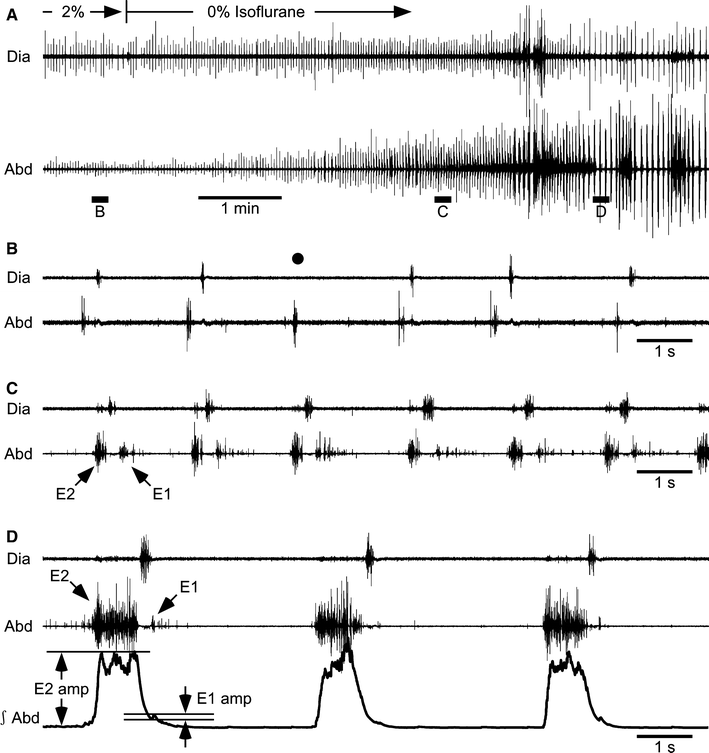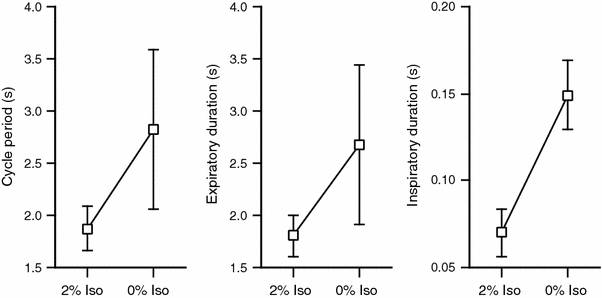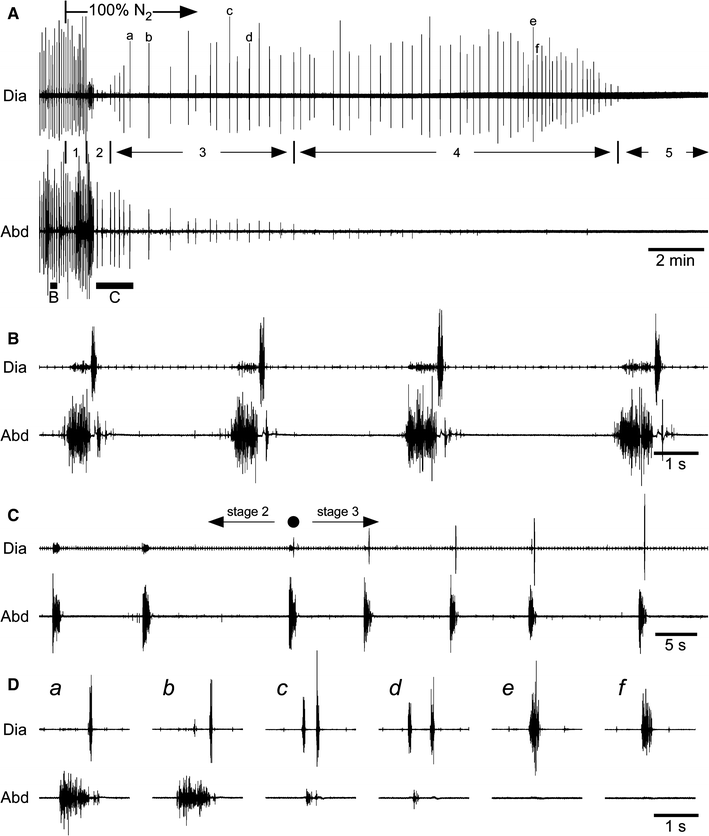Abdominal expiratory muscle activity in anesthetized vagotomized neonatal rats
- PMID: 19340545
- PMCID: PMC10717712
- DOI: 10.1007/s12576-009-0020-3
Abdominal expiratory muscle activity in anesthetized vagotomized neonatal rats
Abstract
The pattern of respiratory activity in abdominal muscles was studied in anesthetized, spontaneously breathing, vagotomized neonatal rats at postnatal days 0-3. Anesthesia (2.0% isoflurane, 50% O(2)) depressed breathing and resulted in hypercapnia. Under this condition, abdominal muscles showed discharge late in the expiratory phase (E2 activity) in most rats. As the depth of anesthesia decreased, the amplitude of discharges in the diaphragm and abdominal muscles increased. A small additional burst frequently occurred in abdominal muscles just after the termination of diaphragmatic inspiratory activity (E1 or postinspiratory activity). Since this E1 activity is not often observed in adult rats, the abdominal respiratory pattern likely changes during postnatal development. Anoxia-induced gasping after periodic expiratory activity without inspiratory activity, and in most rats, abdominal expiratory activity disappeared before terminal apnea. These results suggest that a biphasic abdominal motor pattern (a combination of E2 and E1 activity) is a characteristic of vagotomized neonatal rats during normal respiration.
Figures



Similar articles
-
Abdominal respiratory motor pattern in the rat.Adv Exp Med Biol. 2010;669:157-61. doi: 10.1007/978-1-4419-5692-7_31. Adv Exp Med Biol. 2010. PMID: 20217340 Review.
-
Vagal afferent control of abdominal expiratory activity in response to hypoxia and hypercapnia in rats.Respir Physiol Neurobiol. 2014 Nov 1;203:90-7. doi: 10.1016/j.resp.2014.08.011. Epub 2014 Sep 10. Respir Physiol Neurobiol. 2014. PMID: 25218412
-
Anoxic persistence of lumbar respiratory bursts and block of lumbar locomotion in newborn rat brainstem spinal cords.J Physiol. 2007 Dec 1;585(Pt 2):507-24. doi: 10.1113/jphysiol.2007.143594. Epub 2007 Oct 11. J Physiol. 2007. PMID: 17932145 Free PMC article.
-
Abdominal expiratory activity in the rat brainstem-spinal cord in situ: patterns, origins and implications for respiratory rhythm generation.J Physiol. 2009 Jul 15;587(Pt 14):3539-59. doi: 10.1113/jphysiol.2008.167502. Epub 2009 Jun 2. J Physiol. 2009. PMID: 19491247 Free PMC article.
-
Respiration-related control of abdominal motoneurons.Respir Physiol Neurobiol. 2011 Oct 15;179(1):80-8. doi: 10.1016/j.resp.2011.01.003. Epub 2011 Jan 19. Respir Physiol Neurobiol. 2011. PMID: 21255690 Review.
Cited by
-
Atoh1-dependent rhombic lip neurons are required for temporal delay between independent respiratory oscillators in embryonic mice.Elife. 2014 May 14;3:e02265. doi: 10.7554/eLife.02265. Elife. 2014. PMID: 24842997 Free PMC article.
-
Understanding the rhythm of breathing: so near, yet so far.Annu Rev Physiol. 2013;75:423-52. doi: 10.1146/annurev-physiol-040510-130049. Epub 2012 Oct 29. Annu Rev Physiol. 2013. PMID: 23121137 Free PMC article. Review.
-
Bimodal Respiratory-Locomotor Neurons in the Neonatal Rat Spinal Cord.J Neurosci. 2016 Jan 20;36(3):926-37. doi: 10.1523/JNEUROSCI.1825-15.2016. J Neurosci. 2016. PMID: 26791221 Free PMC article.
-
Expiratory activation of abdominal muscle is associated with improved respiratory stability and an increase in minute ventilation in REM epochs of adult rats.J Appl Physiol (1985). 2015 Nov 1;119(9):968-74. doi: 10.1152/japplphysiol.00420.2015. Epub 2015 Sep 3. J Appl Physiol (1985). 2015. PMID: 26338455 Free PMC article.
References
-
- Janczewski WA, Aoki M. Expiratory activity in the 1–4 day old rat. Jpn J Physiol. 1999;49(Suppl):S84.
-
- Janczewski WA, Aoki M. Expiratory muscle activity in neonatal rats. Soc Neurosci Abst. 1999;25:279.
MeSH terms
Substances
LinkOut - more resources
Full Text Sources
Research Materials

